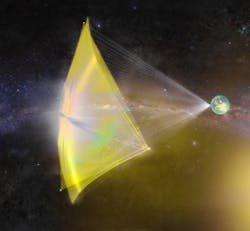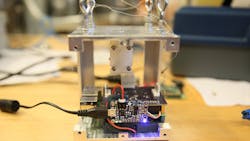Advances in Microsatellite Propulsion Propel Deep-Space Exploration, Maneuverability
Download this article in PDF format.
The word far is an understatement when it comes to the vast distances between celestial bodies. The distance between the sun and our farthest planet Neptune is 2.7 billion miles—it would take astronauts roughly a dozen years to get there using current technology. The farther out into space you go, miles start to lose their meaning and light-years come into play. To put that into perspective, Alpha Centauri A/B, our closest neighboring star (actually, a binary system of two suns), is 4.3 light-years from Earth or roughly 25 trillion miles.
Breakthrough Initiatives’ Starshot is involved in developing a proof-of-concept for unmanned space flight that travels at 20% the speed of light. (Credit: Breakthrough Initiatives)
Suffice to say, it would take us around 137,000 years to get to our nearest neighbor, a lofty goal we could never reach by today’s technological standards. We would have to travel at the speed of light or close to it, to get there in a reasonable enough timeframe, something that is currently beyond our reach… or is it? An ongoing endeavor by Breakthrough Intiatives is looking at getting us our first poolside glimpse of Alpha Centauri and other neighboring stars in just 20 years by sending tiny microsatellites.
Founded and funded by Russian billionaire Yuri Milner, Breakthrough Initiatives is an aspiring program centered on searching for intelligent alien life forms throughout the universe. The program is actually broken down into several projects to achieve this goal:
- Breakthrough Listen: A program that will enable scientists to listen for alien signals utilizing thousands of hours of dedicated radio telescope time that includes Green Bank Observatory, Parkes Observatory, as well as visible light communication from the Automated Planet Finder. Scientists will search for intelligent signals from 1 million of the nearest stars and 100 of the closest galaxies.
- Breakthrough Message: A $1 million competition to compose a message representing life on Earth that could be “read” or decoded by another civilization.
- Breakthrough Watch: A multi-million dollar initiative to advance Earth and space-based technology to find nearby “Goldilocks” planets that could harbor life.
- Breakthrough Starshot: Develop proof-of-concept of ultra-light unmanned space flight that can travel at 20% of the speed of light and lay the foundation for a flyby mission to Alpha Centauri within a generation.
While all of the projects outlined in the program are intriguing, Starshot is perhaps the most fascinating: Traveling at 20% of the speed of light opens up a new world of possibilities of exploration that would be unprecedented even for a generation. To accomplish this goal, Breakthrough is designing its own microsatellite (or Nanocraft) code-named StarChip, a centimeter-sized “interstellar spacecraft.”
Think of it like a tiny single-board controller (SBC) outfitted with four sub-gram digital cameras with a minimum of 2 Mpixels of resolution. Accompanying those cameras are four onboard processors, four photon thrusters, an array of sensors, and a 150-mg atomic battery powered by either plutonium-238 or americium-241. The hardware will feature a protective coating (possibly beryllium copper) to deflect damage from dust and radiation particles as it travels.
A powerful Earth-based laser array will provide propulsion for the tiny satellites. (Credit: Breakthrough Initiatives)
To get the craft up to speed, an Earth-based, kilometer-scale, phased laser array will pulse (at 100-gigawatt levels) photons at the craft, which will push a connected light sail to its destination, increasing its speed with each pulse. The sail is the key—it needs to be composed of robust materials (graphene perhaps?) that won’t disintegrate the planned meter-wide, atoms-thick sail. So far, the team behind Starshot has succeeded in deploying “Sprites,” space probe prototype precursors of the StarChip into low-earth orbit, a great first step in exploring deep space.
Taking on Water
Most satellites maneuver using a chemical propellant deployed by thrusters, which makes sense considering most conventional satellites are large and therefore have the needed room for the chemical systems. Not so for microsatellites or CubeSats. These typically rely on reaction wheels, magnetorquers, or tiny air-based thrusters for attitude control and movement.
Well, now we can add a fourth method of propulsion thanks to some clever researchers from Purdue University, who designed a new micro engine system that uses ultra-purified water vapor for movement while in orbit. The new system, known as a Film-Evaporation MEMS Tunable Array (FEMTA) Thruster, features tiny capillaries (10 mm thick) to harness the power of water.
Purdue University harnessed the power of vaporized water for CubeSat propulsion. (Credit: Purdue University)
To provide thrust, small heaters are located near the ends of the capillaries, which vaporizes the water as it flows from the tiny tubes. What’s interesting is that because of the capillaries’ micro size, the surface tension of the water keeps it from flowing out. When the heaters are activated, the tension is released at the capillary end, and the water can then freely flow, acting much like an on/off valve, or in a similar fashion to an inkjet printer.
Incredibly, the tiny FEMTA Thruster has demonstrated a thrust-to-power ratio of 230 micronewtons per watt for impulses lasting 80 seconds long. To put that into perspective, it’s enough power to rotate a CubeSat 180° in under a minute using less than a quarter-watt of power.
Purdue’s CubeSat FEMTA Thruster engine reached a thrust-to-power ratio of 230 micronewtons per watt for impulses lasting 80 seconds long. (Credit: Purdue University)
The researchers used commercially available parts to design their new thrusters, most of which are integral for IoT devices, including an inertial measurement unit that controls the satellite’s movement. An onboard microcontroller processes the data collected from the sensor and triggers the FEMTA Thruster to achieve the needed movement. The platform has yet to be tested (except in a vacuum chamber); researchers would like to outfit their new system on a mission-ready satellite sometime in the near future.
These are just two examples of new propulsion methods that can be harnessed for both deep-space exploration and low-earth orbit expeditions. As new technology advances continue to arrive, other propulsion options will undoubtedly follow. It will be interesting to see what the future holds and what discoveries come from it.
About the Author
Cabe Atwell
Engineer, Machinist, Maker, Writer. A graduate Electrical Engineer actively plying his expertise in the industry and at his company, Gunhead. When not designing/building, he creates a steady torrent of projects and content in the media world. Many of his projects and articles are online at element14 & SolidSmack, industry-focused work at EETimes & EDN, and offbeat articles at Make Magazine. Currently, you can find him hosting webinars and contributing to Penton’s Electronic Design and Machine Design.





